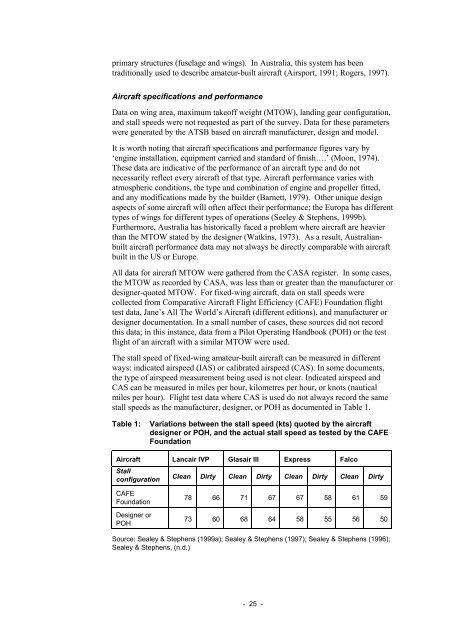Amateur-built and experimental aircraft - Australian Transport Safety ...
Amateur-built and experimental aircraft - Australian Transport Safety ...
Amateur-built and experimental aircraft - Australian Transport Safety ...
You also want an ePaper? Increase the reach of your titles
YUMPU automatically turns print PDFs into web optimized ePapers that Google loves.
primary structures (fuselage <strong>and</strong> wings). In Australia, this system has been<br />
traditionally used to describe amateur-<strong>built</strong> <strong>aircraft</strong> (Airsport, 1991; Rogers, 1997).<br />
Aircraft specifications <strong>and</strong> performance<br />
Data on wing area, maximum takeoff weight (MTOW), l<strong>and</strong>ing gear configuration,<br />
<strong>and</strong> stall speeds were not requested as part of the survey. Data for these parameters<br />
were generated by the ATSB based on <strong>aircraft</strong> manufacturer, design <strong>and</strong> model.<br />
It is worth noting that <strong>aircraft</strong> specifications <strong>and</strong> performance figures vary by<br />
‘engine installation, equipment carried <strong>and</strong> st<strong>and</strong>ard of finish….’ (Moon, 1974).<br />
These data are indicative of the performance of an <strong>aircraft</strong> type <strong>and</strong> do not<br />
necessarily reflect every <strong>aircraft</strong> of that type. Aircraft performance varies with<br />
atmospheric conditions, the type <strong>and</strong> combination of engine <strong>and</strong> propeller fitted,<br />
<strong>and</strong> any modifications made by the builder (Barnett, 1979). Other unique design<br />
aspects of some <strong>aircraft</strong> will often affect their performance; the Europa has different<br />
types of wings for different types of operations (Seeley & Stephens, 1999b).<br />
Furthermore, Australia has historically faced a problem where <strong>aircraft</strong> are heavier<br />
than the MTOW stated by the designer (Watkins, 1973). As a result, <strong>Australian</strong><strong>built</strong><br />
<strong>aircraft</strong> performance data may not always be directly comparable with <strong>aircraft</strong><br />
<strong>built</strong> in the US or Europe.<br />
All data for <strong>aircraft</strong> MTOW were gathered from the CASA register. In some cases,<br />
the MTOW as recorded by CASA, was less than or greater than the manufacturer or<br />
designer-quoted MTOW. For fixed-wing <strong>aircraft</strong>, data on stall speeds were<br />
collected from Comparative Aircraft Flight Efficiency (CAFE) Foundation flight<br />
test data, Jane’s All The World’s Aircraft (different editions), <strong>and</strong> manufacturer or<br />
designer documentation. In a small number of cases, these sources did not record<br />
this data; in this instance, data from a Pilot Operating H<strong>and</strong>book (POH) or the test<br />
flight of an <strong>aircraft</strong> with a similar MTOW were used.<br />
The stall speed of fixed-wing amateur-<strong>built</strong> <strong>aircraft</strong> can be measured in different<br />
ways: indicated airspeed (IAS) or calibrated airspeed (CAS). In some documents,<br />
the type of airspeed measurement being used is not clear. Indicated airspeed <strong>and</strong><br />
CAS can be measured in miles per hour, kilometres per hour, or knots (nautical<br />
miles per hour). Flight test data where CAS is used do not always record the same<br />
stall speeds as the manufacturer, designer, or POH as documented in Table 1.<br />
Table 1: Variations between the stall speed (kts) quoted by the <strong>aircraft</strong><br />
designer or POH, <strong>and</strong> the actual stall speed as tested by the CAFE<br />
Foundation<br />
Aircraft Lancair IVP Glasair III Express Falco<br />
Stall<br />
configuration<br />
Clean Dirty Clean Dirty Clean Dirty Clean Dirty<br />
CAFE<br />
Foundation<br />
Designer or<br />
POH<br />
78 66 71 67 67 58 61 59<br />
73 60 68 64 58 55 56 50<br />
Source: Sealey & Stephens (1999a); Sealey & Stephens (1997); Sealey & Stephens (1996);<br />
Sealey & Stephens, (n.d.)<br />
- 25 -

















